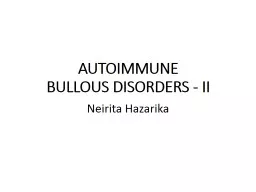

Neirita Hazarika BULLOUS PEMPHIGOID Acquired non scarring autoimmune blistering disease Age elderly Histology subepidermal bullae Immunopathologically deposition of ID: 912785
Download Presentation The PPT/PDF document "AUTOIMMUNE BULLOUS DISORDERS - II" is the property of its rightful owner. Permission is granted to download and print the materials on this web site for personal, non-commercial use only, and to display it on your personal computer provided you do not modify the materials and that you retain all copyright notices contained in the materials. By downloading content from our website, you accept the terms of this agreement.
Slide1
AUTOIMMUNEBULLOUS DISORDERS - II
Neirita
Hazarika
Slide2BULLOUS PEMPHIGOID
Slide3Acquired, non scarring, autoimmune, blistering disease
Age – elderly
Histology –
subepidermal
bullae
Immunopathologically
– deposition of
AutoAb
and complement along basement membrane zone (BMZ)
Slide4ANTIGENS - BPAg1 (230kDa) or BP 230
BPAg
2 (180kDa) or BP 180
Slide5BP 230
Intracellular protein synthesized by basal
keratinocytes
Component of
cytoplasmic
plaque of hemi-
desmosome
Slide6BP 180
Hemidesmosomal
glycoprotein of basal
keratinocytes
Spans lamina
lucida
of
dermoepidermal
junction
Has a short non
collagenuous
extracellular domain and a long non
collagenuous
ectodomain
that interacts with anchoring filaments of the basement membrane
Auto
Ab
directed against short NC 16A
ectodomain
Slide7Slide8ANTIBODIES
Anti BMZ antibodies in BP –
IgG
1 and
IgG
4
Ig
E (occasionally)
IgG
4 and
IgE
target BP 180Ag in
Bullous
Pemphigoid
Serum levels of
IgG
4 and
IgE
reflect disease activity
Slide9Slide10CLINICAL FEATURES
Age- elderly 60-75
M>F
Tense vesicles and
bullae
on
urticated
base/ normal skin
Containing clear to turbid to
haemorrhagic
fliud
Roof remain intact for several days as bullae is
subepidermal
.
Sites – lower abdomen, inner thighs, groin, flexural aspects of limbs
Palms and soles – occasional
Nikolsky’s
sign –
ve
Asboe Hansen’s sign –
ve
Slide11Slide12Blister collapse and re-
epithelialize
For blisters that rupture, resulting erosions do not spread
Erosions heal without scarring-post inflammatory
pigmentary
changes,
milia
Musosa
- 10-40%
Pruritus
common; may precede several years
Slide13CLINICAL VARIANTS
Localised
Childhood
Vesicular
Vegetating
Nodular
Drug induced
Slide14Drug induced
pemphigus
Oral drugs- penicillin,
ampicillin
,
penicillamine
,
frusemide,PUVA
therapy, anti diabetics, sulfonamides,
clonidine
,
diclofenac
, ibuprofen,
practolol
.
Topical –
anthralin
, 5-FU,
benzoyl
benzoate
Slide15HISTOLOGY
Subepidermal blister
An intact epidermis as roof of bulla
Blister cavity – neutrophils,
eosiniphils
, fibrin
Slide16Direct
immunono
flourescense
(DIF)
Linear pattern of IgG, mainly IgG4 (90%), along BMZ
C3 deposition in 100% cases
IgG
C3
Slide17Indirect immuno
flourescence
(IIF)
Circulating anti BMZ IgG Ab (70%)
Slide18D/D
Pemphigus
Mucous membrane
pemphigoid
Pemphigoid
Gestationis
Linear
IgA
disease
Dermatitis
herpetiformis
Bullous
drug eruptions
Slide19Bullous pemphigoid vs Pemphigus
Slide20BULLOUS PEMPHIGOID
PEMPHIGUS VULGARIS
Subepidermal blister, eosinophil
redominant
inltrate
, with neutrophils, lymphocytes, and monocytes and macrophages
Suprabasal
blister with
acantholysis
; characteristic “row of tombstones”
Nikolsky sign (−)
Nikolsky sign (+)
Asboe-Hansen sign (−)
Asboe-Hansen sign (+)
Urticarial lesions precede tense
bullae
Flaccid blister on any skin surface;
erosions most commonly observed
Mucous membrane lesions
present in
10%
Mucous membrane lesions presenting sign for majority of patients
BPAg1 (230-kDa) or BPAg2
(180-kDa) or type XVII collagen
Desmoglein
3 (130
kDa
);
desmoglein
1 (160
kDa
)
DIF IgG in basement membrane
DIF IgG in intercellular pattern
Waxing and waning course,
occasional spontaneous
remission
Fatal if untreated
Slide21TREATMENT
1. Suppression Of Inflammation
Corticosteroids –oral daily doses (0.5-0.75/ kg/day) , potent topical steroids
tetracyclin
,
sulfones
2. Suppression Of Auto Ab Formation
high dose corticosteroids – DCP pulse,
azathioprine
,
Mtx
,
cyclosporin
,
cyclophosphamide
3. Removal Of Antigens And
Autoab
-
Plasmapheresis
4.
Immuno
- Modulation – IV
Ig
Slide22DERMATITIS HERPETIFORMIS
Slide23Rare chronic blistering disorder
Intensely
pruritic
grouped vesicles on an
erythematous
base
DIF – granular deposits of
Ig
A in dermal papillae
Associated with an gluten sensitive mostly asymptomatic
enteropathy
Slide24PATHOGENESIS
Predominant
autoantigen
in DH –epidermal
transglutaminase
(
TGe
)
Predominant antibody in DH –
IgA
Pathological processes in skin are initiated when
TGe
-
IgA
immune complexes are deposit in papillary dermis and activate complement
Slide25CLINICAL FEATURES
Age –(2-3)rd decade
Classical lesion start as a vesicles on an
erythematous
, edematous base
later new lesions arrange in groups
intensely itchy
most lesions excoriated; only crusts seen
Site – elbows, knees, buttocks, sacrum, shoulders, posterior scalp,
Symmetrical distribution
Occasionally face
Slide26Slide27Slide28ASSOCIATIONS
Gluten Sensitive
Enteropathy
Gluten protein present in grasses of species
Triticeae
,
eg
. Wheat, rye, barley
Due to non allergic sensitivity to
gliadi
fraction of gluten
Usually asymptomatic
Diarrhoea
,
steatorrhoea
, abdominal distension, wt. loss
Slide29HISTOLOGY
Neutrophillic
microabscesses
in tip of dermal papillae
Slowly tips of dermal papillae separate from the epidermis
Such cleft coalesce to form a
subepidermal
bullae
Slide30DIF
Perilesional
non involved skin – granular deposits of
IgA
in picket shaped appearance
IIF-
no circulating anti BMZ antibodies found
Immunoelectron Microscopy
Amorphous grains of
IgA
deposits - DH bodies
Slide31Slide32D/D
Papular
urticaria
Scabies
Neurotic excoriations
Erythema
multiforme
Slide33TREATMENT
Gluten free diet life long
Dapsone
100-300mg daily
Salfaslazine
0.5- 2g per day
Colchicine
0.6 mg
tid
Slide34THANK YOU